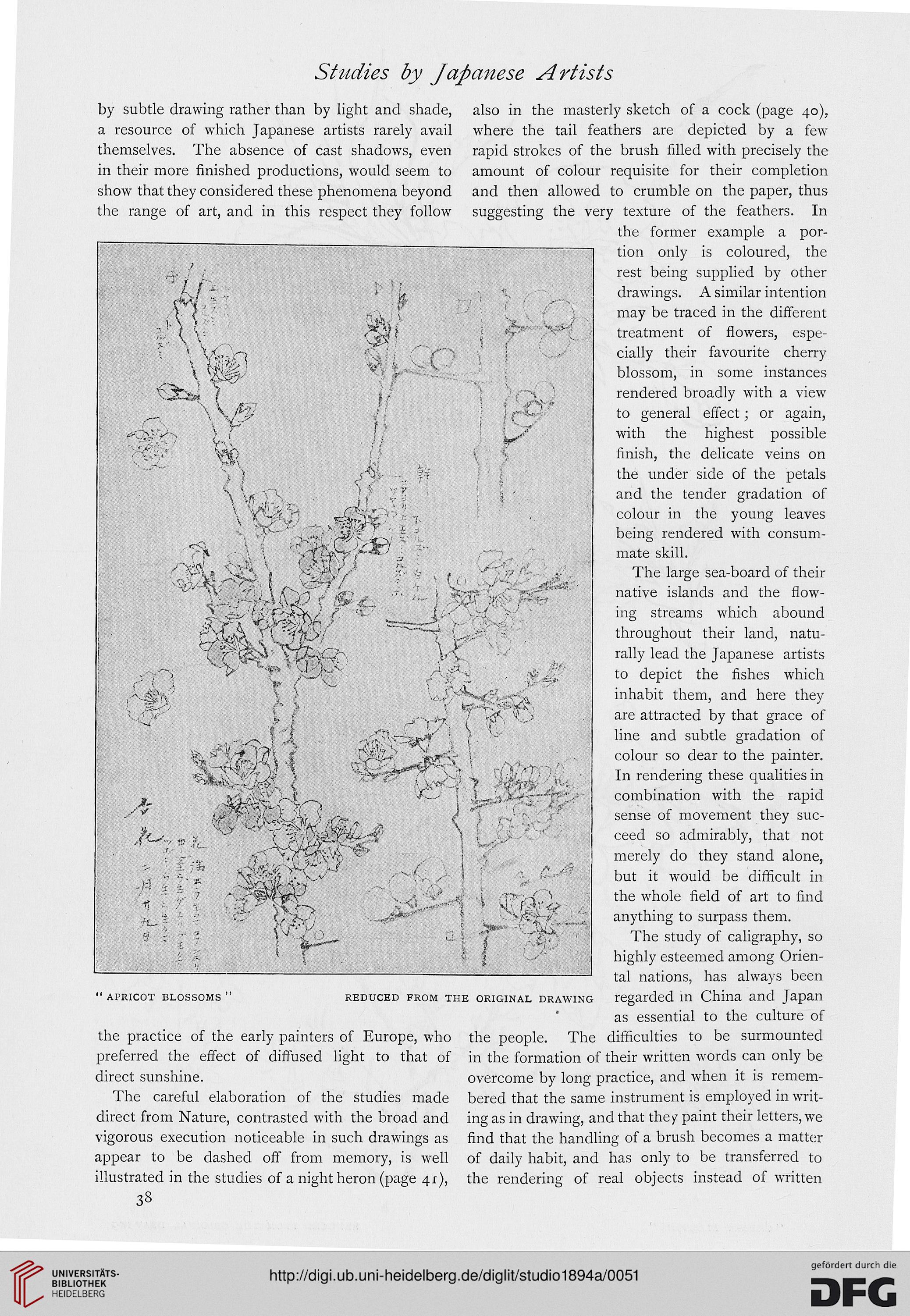Studies by Japanese Artists
by subtle drawing rather than by light and shade, also in the masterly sketch of a cock (page 40),
a resource of which Japanese artists rarely avail where the tail feathers are depicted by a few
themselves. The absence of cast shadows, even rapid strokes of the brush filled with precisely the
in their more finished productions, would seem to amount of colour requisite for their completion
show that they considered these phenomena beyond and then allowed to crumble on the paper, thus
the range of art, and in this respect they follow suggesting the very texture of the feathers. In
the former example a por-
tion only is coloured, the
rest being supplied by other
drawings. A similar intention
may be traced in the different
treatment of flowers, espe-
cially their favourite cherry
blossom, in some instances
rendered broadly with a view
to general effect; or again,
with the highest possible
finish, the delicate veins on
the under side of the petals
and the tender gradation of
colour in the young leaves
being rendered with consum-
mate skill.
The large sea-board of their
native islands and the flow-
ing streams which abound
throughout their land, natu-
rally lead the Japanese artists
to depict the fishes which
inhabit them, and here they
are attracted by that grace of
line and subtle gradation of
colour so dear to the painter.
In rendering these qualities in
combination with the rapid
sense of movement they suc-
ceed so admirably, that not
merely do they stand alone,
but it would be difficult in
the whole field of art to find
anything to surpass them.
The study of caligraphy, so
highly esteemed among Orien-
tal nations, has always been
"apricot blossoms" reduced from the original drawing regarded in China and Japan
as essential to the culture of
the practice of the early painters of Europe, who the people. The difficulties to be surmounted
preferred the effect of diffused light to that of in the formation of their written words can only be
direct sunshine. overcome by long practice, and when it is remem-
The careful elaboration of the studies made bered that the same instrument is employed in writ-
direct from Nature, contrasted with the broad and ing as in drawing, and that they paint their letters, we
vigorous execution noticeable in such drawings as find that the handling of a brush becomes a matter
appear to be clashed off from memory, is well of daily habit, and has only to be transferred to
illustrated in the studies of a night heron (page 41), the rendering of real objects instead of written
38
by subtle drawing rather than by light and shade, also in the masterly sketch of a cock (page 40),
a resource of which Japanese artists rarely avail where the tail feathers are depicted by a few
themselves. The absence of cast shadows, even rapid strokes of the brush filled with precisely the
in their more finished productions, would seem to amount of colour requisite for their completion
show that they considered these phenomena beyond and then allowed to crumble on the paper, thus
the range of art, and in this respect they follow suggesting the very texture of the feathers. In
the former example a por-
tion only is coloured, the
rest being supplied by other
drawings. A similar intention
may be traced in the different
treatment of flowers, espe-
cially their favourite cherry
blossom, in some instances
rendered broadly with a view
to general effect; or again,
with the highest possible
finish, the delicate veins on
the under side of the petals
and the tender gradation of
colour in the young leaves
being rendered with consum-
mate skill.
The large sea-board of their
native islands and the flow-
ing streams which abound
throughout their land, natu-
rally lead the Japanese artists
to depict the fishes which
inhabit them, and here they
are attracted by that grace of
line and subtle gradation of
colour so dear to the painter.
In rendering these qualities in
combination with the rapid
sense of movement they suc-
ceed so admirably, that not
merely do they stand alone,
but it would be difficult in
the whole field of art to find
anything to surpass them.
The study of caligraphy, so
highly esteemed among Orien-
tal nations, has always been
"apricot blossoms" reduced from the original drawing regarded in China and Japan
as essential to the culture of
the practice of the early painters of Europe, who the people. The difficulties to be surmounted
preferred the effect of diffused light to that of in the formation of their written words can only be
direct sunshine. overcome by long practice, and when it is remem-
The careful elaboration of the studies made bered that the same instrument is employed in writ-
direct from Nature, contrasted with the broad and ing as in drawing, and that they paint their letters, we
vigorous execution noticeable in such drawings as find that the handling of a brush becomes a matter
appear to be clashed off from memory, is well of daily habit, and has only to be transferred to
illustrated in the studies of a night heron (page 41), the rendering of real objects instead of written
38




